人教版七年级英语上册Unit 6教案
- 格式:docx
- 大小:22.39 KB
- 文档页数:7
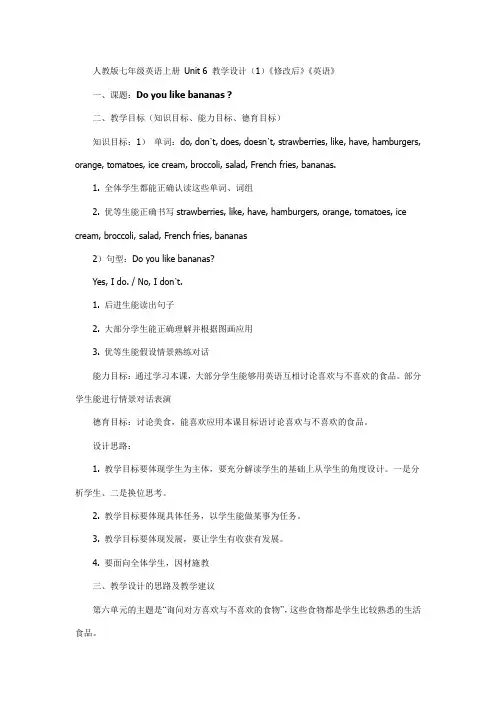
人教版七年级英语上册Unit 6 教学设计(1)《修改后》《英语》一、课题:Do you like bananas ?二、教学目标(知识目标、能力目标、德育目标)知识目标:1)单词:do, don’t, does, doesn’t, strawberries, like, have, hamburgers, orange, tomatoes, ice cream, broccoli, salad, French fries, bananas.1. 全体学生都能正确认读这些单词、词组2. 优等生能正确书写strawberries, like, have, hamburgers, orange, tomatoes, ice cream, broccoli, salad, French fries, bananas2)句型:Do you like bananas?Yes, I do. / No, I don’t.1. 后进生能读出句子2. 大部分学生能正确理解并根据图画应用3. 优等生能假设情景熟练对话能力目标:通过学习本课,大部分学生能够用英语互相讨论喜欢与不喜欢的食品。
部分学生能进行情景对话表演德育目标:讨论美食,能喜欢应用本课目标语讨论喜欢与不喜欢的食品。
设计思路:1. 教学目标要体现学生为主体,要充分解读学生的基础上从学生的角度设计。
一是分析学生、二是换位思考。
2. 教学目标要体现具体任务,以学生能做某事为任务。
3. 教学目标要体现发展,要让学生有收获有发展。
4. 要面向全体学生,因材施教三、教学设计的思路及教学建议第六单元的主题是“询问对方喜欢与不喜欢的食物”,这些食物都是学生比较熟悉的生活食品。
在教学时老师能够使用实物进行教学,增强学生的学习兴趣和学习效果。
在传授新知识时,为了为学生创设真实的,贴近生活的情境,可以设计一些游戏,即根据不同人对食物的不同喜好,自配营养餐和填写购物清单等,这样不但激发了学生学习的热情,也达到了练习重点句型的目的。

单元教案Do you like bananas?教材依据:新目标英语七年级上册第六单元教学目标(一)语言知识1、词汇:本单元所要求掌握的所有词汇2、日常交际用语:Do you like …? Yes,I do./No, I don’t.I /They like oranges. I/They don’t like bananas.She likes salad. She doesn’t like salad.3、教学重点:1、掌握各种不同的有关食物方面的名词;2、实义动词like 一般现在时的否定式、疑问式及其答语;3、助动词do /does和don’t/doesn’t的用法;4、一日三餐的营养搭配5、小短文的写作4、教学难点:1、Affirmative and negative statements2、Countable nouns and uncountable nouns3、How to talk about likes and dislikes(二)语言技能学生能认识及听懂各种不同的食物名称,区分可数名词和不可数名词,并能自由表达出自己喜欢和不喜欢的食物;能根据单元所学句型自编对话,讨论自己及他人喜欢和不喜欢的食物并扩展到其他方面(如sports),能进行小组讨论并用英语进行简单的陈述(I like…, I don’t like …,he likes…,he doesn’t like….),能进行一日三餐的营养搭配,能根据课前任务收集和整理资料,并对所得资料进行加工和处理,在课堂中合理地加以运用。
(三)学习策略通过学习课文,掌握有关饮食方面的词汇,并结合所学单词,自由讨论喜好。
通过在课文中交流彼此的特长和爱好,培养群体意识,并在小组讨论及合作中,学会合作学习与研究性学习,完成所给任务,努力开拓课程资源。
(四)情感态度激发学生英语学习的欲望和兴趣,敢于用英语进行交流和表达; 营造情感交融的良好氛围,努力提高学生的学习兴趣,学生自主学习、主动合作;认真完成课前任务,在调查中充分发挥自身潜力,培养思维能力、动手能力、开展研究性学习;(五)文化意识能了解东西方不同的饮食文化。
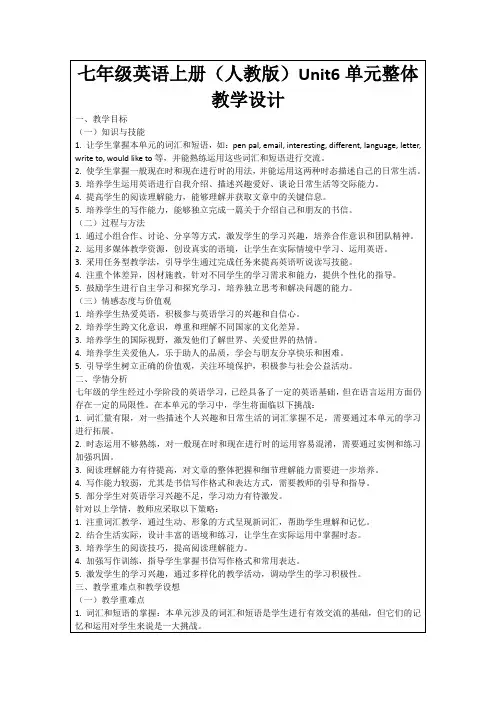
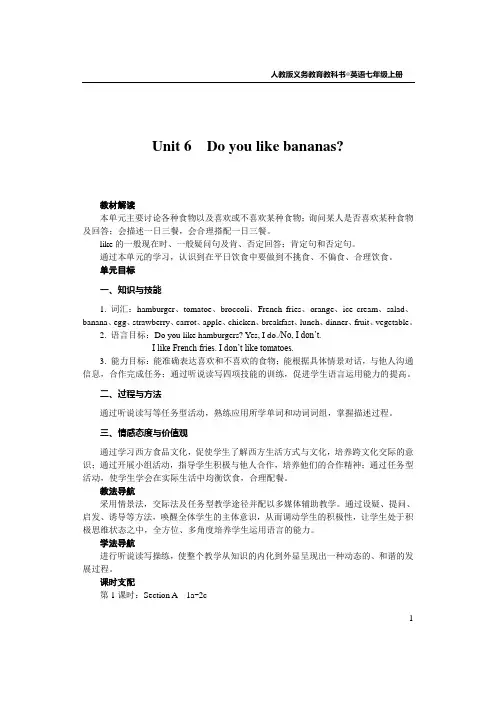
人教版义务教育教科书◎英语七年级上册Unit 6 Do you like bananas?教材解读本单元主要讨论各种食物以及喜欢或不喜欢某种食物;询问某人是否喜欢某种食物及回答;会描述一日三餐,会合理搭配一日三餐。
like的一般现在时、一般疑问句及肯、否定回答;肯定句和否定句。
通过本单元的学习,认识到在平日饮食中要做到不挑食、不偏食、合理饮食。
单元目标一、知识与技能1. 词汇:hamburger、tomatoe、broccoli、French fries、orange、ice cream、salad、banana、egg、strawberry、carrot、apple、chicken、breakfast、lunch、dinner、fruit、vegetable。
2.语言目标:Do you like hamburgers? Yes, I do./No, I don’t.I like French fries. I don’t like tomatoes.3. 能力目标:能准确表达喜欢和不喜欢的食物;能根据具体情景对话,与他人沟通信息,合作完成任务;通过听说读写四项技能的训练,促进学生语言运用能力的提高。
二、过程与方法通过听说读写等任务型活动,熟练应用所学单词和动词词组,掌握描述过程。
三、情感态度与价值观通过学习西方食品文化,促使学生了解西方生活方式与文化,培养跨文化交际的意识;通过开展小组活动,指导学生积极与他人合作,培养他们的合作精神;通过任务型活动,使学生学会在实际生活中均衡饮食,合理配餐。
教法导航采用情景法,交际法及任务型教学途径并配以多媒体辅助教学。
通过设疑、提问、启发、诱导等方法,唤醒全体学生的主体意识,从而调动学生的积极性,让学生处于积极思维状态之中,全方位、多角度培养学生运用语言的能力。
学法导航进行听说读写操练,使整个教学从知识的内化到外显呈现出一种动态的、和谐的发展过程。
课时支配第1课时:Section A 1a-2c1第2课时:Section A 3a-3c第3课时:Section B 1a-2c第4课时:Section B 3a-Self Check课时教案第1课时Section A1a-2c教学目标一、知识与技能1. 掌握基本词汇:food、banana、hamburger、tomato、broccoli、French fries、strawberry、orange、ice cream、salad。
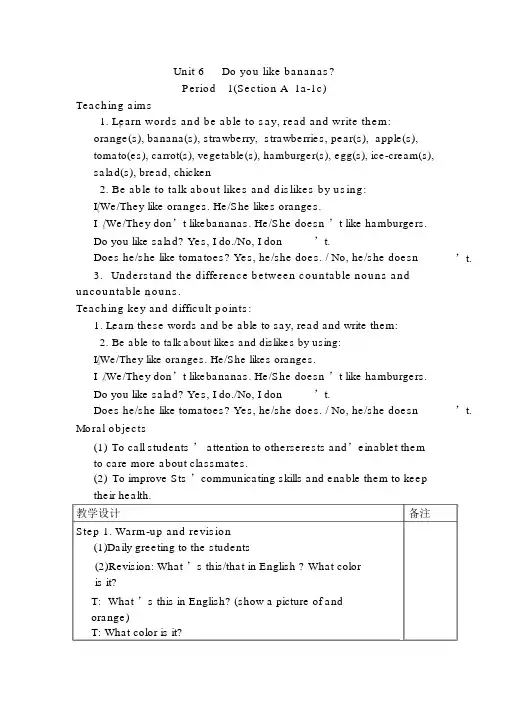
Unit 6Do you like bananas?Period 1(Section A 1a-1c)Teaching aims1. Learn words and be able to say, read and write them:orange(s), banana(s), strawberry, strawberries, pear(s), apple(s),tomato(es), carrot(s), vegetable(s), hamburger(s), egg(s), ice-cream(s),salad(s), bread, chicken2. Be able to talk about likes and dislikes by using:I/We/They like oranges. He/She likes oranges.I /We/They don’t likebananas. He/She doesn’t like hamburgers.Do you like salad? Yes, I do./No, I don’t.Does he/she like tomatoes? Yes, he/she does. / No, he/she doesn’t.3.Understand the difference between countable nouns and uncountable nouns.Teaching key and difficult points:1.Learn these words and be able to say, read and write them:2.Be able to talk about likes and dislikes by using:I/We/They like oranges. He/She likes oranges.I /We/They don’t likebananas. He/She doesn’t like hamburgers.Do you like salad? Yes, I do./No, I don’t.Does he/she like tomatoes? Yes, he/she does. / No, he/she doesn’t. Moral objects(1)To call students ’ attention to otherserests and’ei n ablet themto care more about classmates.(2)To improve Sts ’communicating skills and enable them to keeptheir health.教学设计备注Step 1. Warm-up and revision(1)Daily greeting to the students(2)Revision: What ’s this/that in English ? What coloris it?T:What ’s this in English? (show a picture of andorange)T:What color is it?Step 2. Presentation –New words.(1)Go on asking: What ’s this/that in English ? Whatcolor is it?T:What ’s this in English? (show a picture of anapple and if the student don’t know it, show thephonetic symbol of the word.)T: Spell it, please.S: A-P-P-L-E.T: What color is it?S: It ’s red.(Present the other three words as above: pear,strawberry, banana )T:We can call all of these things fruit . (Teach the newword “fruit ”.)Show pictures and ask the Ss “What arethese/those? ”and ask the SS to spell the pluralforms of these words: oranges, apples, pears,strawberries, bananas.(2)Repeat step (1) to present: carrot, carrots,tomato, tomatoes and vegetable, vegetables.(3)Present some more words by showing pictures. Get theSs to make an effort to pro nounce and spell the new words.Bread, hamburger ,hamburgers, milk, ice-cream,ice-creams, salad, chicken ,an egg, eggsWe can call all of these things food:食物3.Memory Challenge: Who has the best eyes?(1)Show the pictures, and say the plural forms of the nouns andsome uncountable noun.(2)Summarize. 可数名词有复数形式 , 不可数名词一般没有复数形式Step 3Presentation Target language 11. Show the pictures and say:I like tomatoes, but I don’ t like bread.2.Let students say:I like, but I don’t like ....3. Show the pictures and say:She likes bread, but she doesn’t like milk.He likes chicken, but he doesn’t like eggs.4.Let students say: He/She likes , but he/she doesn’tlike ....According Ss’answers and say:5. Sing a chant:Bananas, bananas, I like bananas! Salad, salad, I like salad!Strawberries, strawberries,I don ’t like strawberries!Pears, pears, he likes pears!Milk , milk, he likes milk!Tomatoes, tomatoes,He doesn ’t like tomatoes! Step 4 Work 1a .1. Read the words.2.T: Look at the pictures and fill in the chart .Fruit Food Vegetable3.Match the words with the things in the picture.4.Check the answers .Step 5 Present the new language 1 .1. T: Oh, we have lots of delicious fruits . I like apples best.Do you like apples ?S1 :Yes , I do. I like apples.S2: No, I don't . I like salad.T: Do you like salad ? S3: Yes , I do. I like salad./ No, I don't . I don’tlike salad.Step 6 Pairwork .1. T: Work in pairs .Ask and answer with your partners .(Before class the students have draw some pictures of the food )2. Get the Ss to ask and answer in pairs, using the sentences:’t.A: Do you like ?B: Yes, I do./ No, I don 3. When you ask andanswer, please fill in the chart. Name Like DislikeStep 7 Present the new language 2 .1.Show pictures and ask and answer questionsDoes she/he like ?Yes, she/he does. She/He likes/ No, she/he doesn ’t. She/He doesn ’tlike .Step 8 Pairwork .1. T: Work in pairs .Ask and answer with your partners .2.Get the Ss to ask and answer in pairs, using the sentences:Does she/he like ?Yes, she/he does. She/He likes/ No, she/he doesn ’t. She/He doesn ’tlike .3.According Ss’answers and ask “Do they like ? Yes, they do./ No, they don’t.”Step 9 Work on 1b.1.T: 1b. List en and number the conversations.2.Listen.3.Check the answers.4.Read after the tape.Step 10 work on 1c.1.First, practice the conversations in 1b.Then, make a survey and fill in the chart below.2. Report: I like milk and tomatoes, but I don’t like ice-cream. Mary likes oranges, but she doesn’liket milk orice-cream. Tom likes tomatoes and strawberries, but hedoesn ’ t like bread.Step 11 . HomeworkWrite down the report.Blackboard design:New Words Unit 6 Do you like bananas?Do you like?Yes , I do. I likeNo ,I don ’t. I don ’tlikeDoes she/he like ?Yes, she/he does. She/He likes/No, she/he doesn ’t. She/He doesn ’tlike.Period 2(Section A 2a-2d)Teaching aims:1. Words & expressionsBirthday, dinner, week, think about, food, sure, how/whatabout ? Burger, vegetable, fruit, apple, then2. Target languageI like strawberries, they’re delicious. Let’s have them.--Yes, I like them ,too./ No, I don’tlike them.I like salad, it ’s delicious. Do you like it?-- Yes, I do./No, I don’t but I likeice cream.Let ’ s have Let ’s think about the food.Ability goalsEnable students to talk about likes and dislikes.Learning ability goalsHelp students learn how to talk about likes and dislikes.2. Listening and speaking skills.Moral object:Learn to keep healthy.Teaching important / difficult pointsHow to talk about likes and dislikes with the target language.教学设计备注Step1 Warm up and revision.1.Everyday greeting.2.Review.Show the pictures and say the singularforms and the plural forms of the countable nouns.3.Show some pictures of the uncountable nouns.4.Summarize.(1).当可数名词复数再次出现时,用“They( 主语)或 them(宾语)”替代。
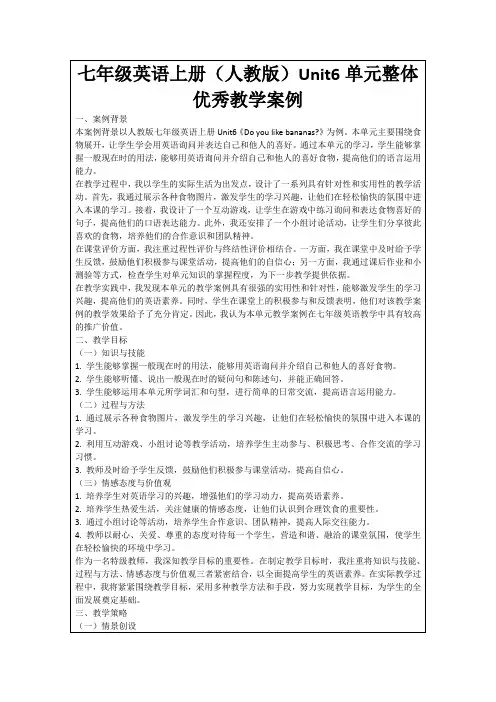
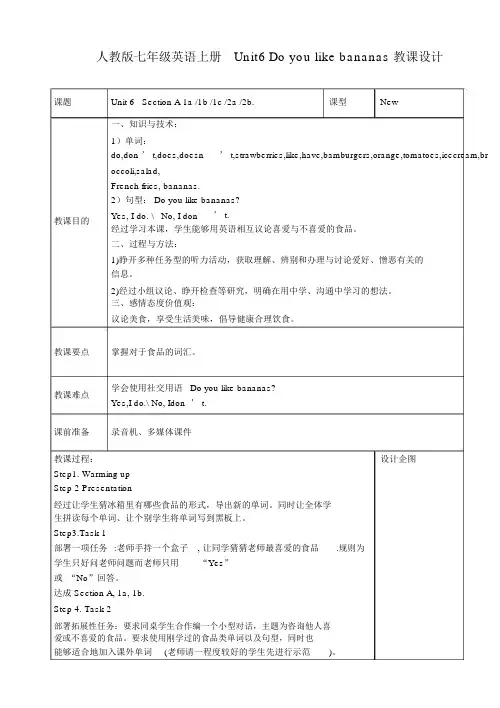
人教版七年级英语上册Unit6 Do you like bananas教课设计课题Unit 6 Section A 1a /1b /1c /2a /2b.课型New一、知识与技术:1)单词:do,don ’ t,does,doesn’ t,strawberries,like,have,bamburgers,orange,tomatoes,icecream,broccoli,salad,French fries, bananas.2)句型: Do you like bananas?教课目的Yes, I do. \ No, I don’ t.经过学习本课,学生能够用英语相互议论喜爱与不喜爱的食品。
二、过程与方法:1)睁开多种任务型的听力活动,获取理解、辨别和办理与讨论爱好、憎恶有关的信息。
2)经过小组议论、睁开检查等研究,明确在用中学、沟通中学习的想法。
三、感情态度价值观:议论美食,享受生活美味,倡导健康合理饮食。
教课要点掌握对于食品的词汇。
教课难点学会使用社交用语 Do you like bananas? Yes,I do.\ No, Idon ’ t.课前准备录音机、多媒体课件教课过程:设计企图Step1. Warming upStep 2 Presentation经过让学生猜冰箱里有哪些食品的形式,导出新的单词。
同时让全体学生拼读每个单词、让个别学生将单词写到黑板上。
Step3.Task 1部署一项任务:老师手持一个盒子, 让同学猜猜老师最喜爱的食品.规则为学生只好问老师问题而老师只用“Yes”或“No”回答。
达成 Section A, 1a, 1b.Step 4. Task 2部署拓展性任务:要求同桌学生合作编一个小型对话,主题为咨询他人喜爱或不喜爱的食品。
要求使用刚学过的食品类单词以及句型,同时也能够适合地加入课外单词(老师请一程度较好的学生先进行示范)。
Step 5.达成课文32 页 Section A 听力练习activity 2a, 2b.Setp 6.当堂听写听写单词与句型,进一步稳固本课学习内容,并将本课应掌握的单词和句型落实到“写”上,使学生不只会说同时会写。
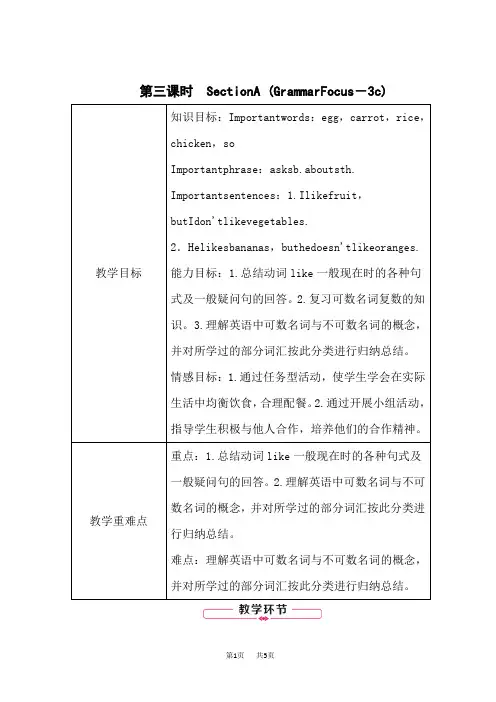
第三课时SectionA (GrammarFocus-3c)Step1 情景导入【参考案例】T:Doyouliketomatoes/oranges/salad…?S1:Yes,Ido./No,Idon't,butIlike…T:Doesshe/heliketomatoes/oranges/salad…?S2:Yes,she/hedoes./No,she/hedoesn't,butshe/helikes…设计意图:通过师生互动问答复习上节课内容,在问答中提醒学生注意一般现在时态第三人称单数的使用。
Step2 畅通GrammarFocus回顾语法重点【操作案例】1.学生阅读GrammarFocus中的句子,总结含有实义动词的一般现在时的句型规律。
2.阅读方框中可数名词和不可数名词,并对所学过的部分词汇按此分类进行归纳总结。
设计意图:学生通过阅读感知句型规律,并做出总结。
通过阅读方框中可数名词和不可数名词,进一步加深理解。
Step3 完成教材3a-3c的任务【操作案例】1.认真阅读3a的5个句子,并在括号内正确的单词下面画线,使句子正确完整。
2.学生说出答案,老师核对,然后让学生大声朗读这些句子,并背诵。
3.认真阅读3b的几个句子,将其编号,组成对话,然后读背。
4.做食物调查。
用“Doyoulike…?”句型就3c表格中的食物向小组成员提问。
找出他们喜欢和不喜欢的食物,并把结果登记在表格中。
设计意图:学生通过参加活动和练习,更好地掌握本课知识。
知识▲可数名词与不可数名词的含义与特点Step4 随堂练习 根据图示,完成句子。
1.Paullikestomatoesand__icecream __.2.Pauldoesn'tlikehamburgersor__strawberries__. 3.Emmalikes__hamburgers__andstrawberries. 4.Emma__doesn't__like__tomatoes__or__icecream. 5.Paullikestomatoes ,butEmma__doesn't__like__them. Step5 板书设计SectionA (GrammarFocus -3c)Importantwords :egg ,carrot ,rice ,chicken ,so Importantphrase :asksb.aboutsth. Importantsentences :1.Ilikefruit ,butIdon'tlikevegetables. 2.Helikesbananas ,buthedoesn'tlikeoranges.Step6 完成学生用书。
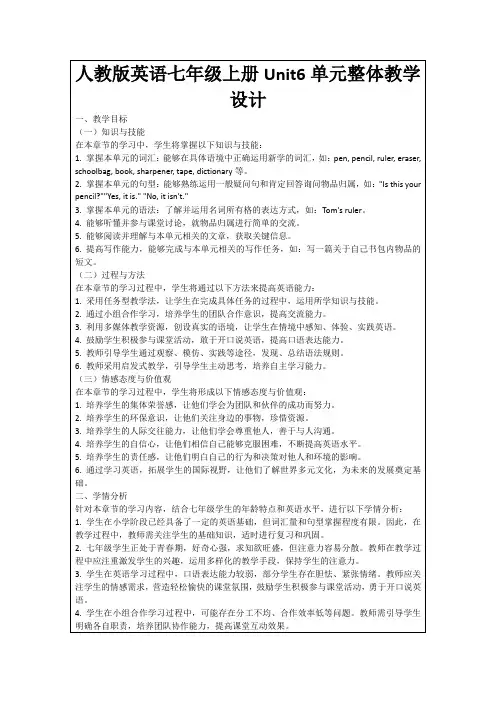
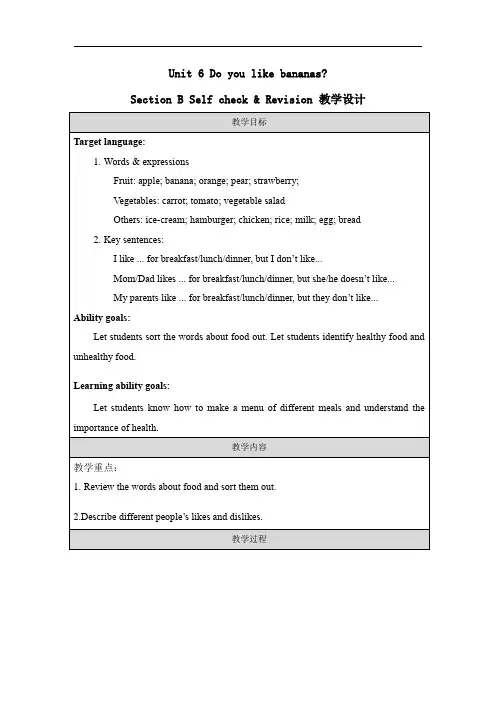
Unit 6 Do you like bananas? Section B Self check & Revision 教学设计Step 1: Warm-upThis week, there will be a Family Day and you need to make a menu of your family’s three meals. What should you do first? Go to find the food in your fridge. Let’s see.Step 2: Revision of vocabulary1.In the fridge, first you can find some fruit. So what fruit can you find? This is astrawberry. This is an apple. This a pear. This is a banana. And this is an orange.2. Then we can find some vegetables. Let’s see what are they? First, this a tomatoand this is a carrot. How about this? It’s vegetable salad.3. Except fruit and vegetables, you can find some other food. For example, there issome ice-cream, a hamburger, chicken, rice, milk, bread and an egg.4. You can see so many kinds of food in the fridge, so if you want to make the menufor your family’s 3 meals, what is very important? Health. Are the foods in the fridge healthy? Put H next to healthy food and U next to unhealthy food.5. So if you want to be healthy, what should we do?You must eat well. It meansyou eat healthy food. And then you have good eating habits.Step 3: Rules of plurals.We’ve learned so many words about food. Some are countable while some are uncountable. For countable nouns, the plural form is also important.1.Self-check 1: Write the plurals of the words in the correct column>2.3.Can you think about more examples about the last 2 groups?+es: potatoes, boxes, watches; y→i+es: libraries4.Now let’s see the rules of plurals.Step 4: Talking about likes and dislikes1.After choosing the healthy food, you need to choose what you and your parents like. We can’t make a menu with food that people dislike.2.Self check 2: Choose the food you like for three meals. Write down 3 sentences.E.g. I like ... for breakfast, but I don’t like...I like ... for lunch, but I don’t like ...I like ... for dinner, but I don’t like.3.Self check 3: How about your parents? Write down 5 sentences about your parents’ likes and dislikes. You can use the following sentence patterns.E.g. Mom/Dad likes... for breakfast/lunch/dinner, but he/she doesn’t like...My parents like ... for breakfast/lunch/dinner, but they don’t like...Homework1.Finish the exercises.2.Make a menu for your Family Day.。

Unit 6Do you like bananas?第一课时Section A(1a-1c)1.重点单词:banana,hamburger,tomato,icecream,salad,strawberry,pear,milk,bread2.重点句式:—Do you like bananas?—Yes,I do.—Do you like salad?—No,I don't.1.用like来谈论喜好2.可数名词的单复数1.用like来谈论喜好2.可数名词的单复数一、预习课本P31新单词并背诵,完成下面的汉译英。
1.香蕉____________ 2.汉堡____________3.西红柿____________ 4.冰激凌__________5.沙拉____________ 6.草莓____________7.梨____________ 8.牛奶____________9.面包____________二、认真预习1a,1b,1c,找出下列句型。
1.—你喜欢香蕉吗?—是的,我喜欢。
________________________________________________________________________ 2.—你喜欢沙拉吗?—不,我不喜欢。
________________________________________________________________________Step 1情景导入Teacher:There are many different kinds of fruits and vegetables in the world,and different people like different food.Everyone has its own taste.What kind of food do you like?What kind of food do you dislike?Today let's talk about the food we like and we dislike in Unit 6.环节说明:由学生感兴趣的话题导入新课,简洁明了,激起学生的学习兴趣。
Unit 6 Section B 1a1e 教学目标To learn some words and expressions about food.To consolidate the structures:Does Tom like carrots?Yes, he does./No, he doesn’t.核心素养To learn some words and expressions about food.重难点To learn some words and expressions about food.To consolidate the structures:Does Tom like carrots?Yes, he does./No, he doesn’t.教学过程Free talkDo you like…for breakfast/lunch/dinner?Does he /she like…for breakfast/lunch/dinner?1a Write the number of each wordnext to the correct food.1.orange 3. eggs 5. icecream 7. banana 9. rice2. salad 4. apple 6. hamburger 8. chicken 10. carrotsI like ...I don’t like...A: Does … like…?B: Yes, he /she does. He/she likes …B: No, he/she doesn’t. He/she doesn’t like …three meals(一日三餐)breakfastWhat do you like for breakfast?I like eggs and milk for breakfast.For breakfast, I like eggs and milk.lunchWhat do you like for lunch?I like chicken and carrots for lunch.For lunch, I like chicken and carrots.What do you think of (你认为……怎么样) the breakfast, lunch and dinner in part 1a?Do you like the breakfast, lunch and dinner? What do you usually have for breakfast, lunch and dinner?I like… I have ______ for breakfast/ lunch/ dinner.How many other words can you add to the lists?fruit: pear, ___________________________________________________________vegetables: __________________________________________________________Listen and circle the food you hear in 1a.1. orange2. salad3. eggs4. apple5. icecream6. hamburger7. banana8. chicken 9. rice 10. carrots1d Listen again. Fill in the chart.Finish the dialogue. Then act it out with your partner.Sally: Do you like carrots?Tom: __________. I like all vegetables.Sally: How about salad? _______________?Tom: Yes, I do. It’s great! Do you likevegetables?Sally: _______________________. Well,only salad. _____________. I likebananas, oranges …Ask and answer questions about what Sally and Tom like and don’t like.Does Tom like carrots?Yes, he does.Does Tom like …?…Work in groupsA:Do you like strawberries for breakfast/lunch/dinner?B:Yes, I do.I like... /No, I don’t.I don’t like…A:Does he/she like strawberries for breakfast/lunch/dinner?C:Yes, he/she does.He/She likes…/No, he/she doesn’t.He/She doesn’t like …GroupworkI like…, but I don’t like ….Report:Eg:Tom likes apples,but he doesn’t like pears.Gina likes oranges,but she doesn’t like salad. Bob likes …,but he doesn’t like …I like…, but I don’t like…Homework1. 用下列句型就你自己的饮食习惯写五到七个句子。
新目标人教版七年级英语上Unit 6Do you likebananas ?一、教学目标:1、知识与能力:通过利用词汇apples,oranges,bananas,hamburgers,tomatoes,broccoli, ice, ice cream, strawberries, pears, salad,等来谈论谈论自己与他人喜欢与不喜欢的食物,使学生掌握一般现在时态(like )的肯定句、否定句、一般疑问句及其肯定回答和否定回答。
并让学生初步认识可数名词与不可数名词。
鼓励学生积极参与课堂活动,从而培养学生大胆开口说英语及实际运用英语进行交际的能力。
2、过程与方法:采用Practicing, Listening, Saying, Reading, Writing and Role playing 等多种策略,利用实物与幻灯片相结合,积极展开Pair work, Group work, Games等一系列活动,询问他人好恶,并了解中外饮食文化。
3、情感目标:该部分学习内容贴近学生的生活,谈论的主题涉及学生的饮食习惯和偏爱,对学生养成健康的饮食习惯很有帮助,能引起学生的特别关注,极易于激发学生学习英语的欲望和兴趣,使他们乐于参与各种英语实践活动。
通过如何询问他人的好恶,增进同学了解,体现对他人的关怀;通过中西饮食习惯的不同,认识中西文化差异的存在,了解并尊重异国文化。
二、教学重、难点:1、重点:(1)、一般现在时(like)的肯定句、否定句、一般疑问句及其肯定回答与否定回答:I / We / You / They like bananas.I /We / You / They don'litke bananas.Do you / They like bananas?Yes, I / they do.No,I / they don'. tHe / She likes bananas.He / Shedoesn'li t ke bananas. Does he / she like bananas? Yes, he / she does .No, he / shedoesn't(2 )、可数名词与不可数名词2、难点:一般现在时(主语为第三人称单数like )的肯定句、否定句、一般疑问句及其肯定回答与否定回答:He / She likes bananas.He / Shedoesn'li t ke bananas.Does he / she like banabnas?Yes, he / she does .No,he / shedoesn't六: 教学准备教师准备:1、自己带上几个水果。
Unit 6 Do you like bananas?单元教材分析:本课包括三部分:Section A, Section B和Self-check.主题: Food.语言功能: Talk about likes and dislikes.询问某人是否喜欢某种食物及回答;表达喜欢什么和不喜欢什么。
语言结构: Present tense to like Yes/No questions and short answersAffirmative and negative statementslike 的一般现在时,一般疑问句及肯、否定回答;肯定句和否定句。
语言目标: 主要语法Do you like hamburgers? Yes, I do. No, I don’t.I like French fries. I don’t like tomatoes.Main vocabulary(词汇): hamburgers, tomatoes, broccoli, French fries, oranges, ice cream, salad, bananas, eggs, strawberry, carrots, apples, chicken, breakfast, lunch, dinner, fruit, vegetable.品德:在平日饮食中要做到不挑食。
根据需要可以分为四课时来讲。
第一课时:I.教材分析:这是本单元的第一部分,生词比较多,但是因为涉及到吃的东西,每个同学都有自己的爱好,学生比较感兴趣。
Language topic: Do you like bananas?Yes, I do. No, I don’t.Language strategies: Talk about likes and dislikes.Main vocabulary: food, banana, hamburger, tomato, broccoli, French fries, strawberry, orange, ice cream, salad II.语言结构: like的一般现在时的一般疑问句及回答。
III.语言功能:询问某人是否喜欢某物及怎样回答.IV.活动设计:采访调查Do you like…?V. Teaching steps:Step 1:Greetings.Step 2: Words: (pictures)What’s this? (picture) It’s a soccer ball. Do you havea soccer ball? Yes, I do. /No, I don’t. Do you like it? Yes, Ido./No, I don’t.What’s this? It’s a hamburger. Do you like it? Yes, I do. No, I don’t.What are these? They’re bananas. Do you like bananas?Yes, I do. / No, I don’t.运用图片和对话教学单词:hamburger, banana, tomato, broccoli, French fries, strawberry, orange, ice cream, salad 并运用这Array些单词进行对话:Do you like…? Yes, I do./No, I don’t.Step 4: 1b Listen and number the conversations 1-3.Do you like salad? No, I don’t. Do you like bananas? Yes, I do.Do you like oranges? Yes, I do.Practice the conversations, and then make your own conversations.Step 5: 2a Listen and circle the food you hear. (P32) hamburgers tomatoes broccoli French fries oranges ice cream salad bananasStep 6: 2b Listen again and fill in the blanks.I like hamburgers. Do you like hamburgers? Yes, Ido.Do you like______: No, I don’t li ke ______.Let’s have _______. Oh, no. I don’t like_________.Step 7: 4 (P33)Make a food survey. Do you like…?How many students like hamburgers?How many students like bananas?日常生活中饮食要做到不偏食,不挑食。
Step 8: Let’s sum what we have learned this class.Words:Sentences:Something else:Step 9: Homework1. Remember the words in this class.2. Practise the dialogue in pairs.教后一得:教完这堂课,感慨颇多。
以前经常埋怨学生厌学,没兴趣,从这节课来看,主要是教师没有认真的去备课,没有去从学生的角度去处理教材,学生当然没兴趣。
这节课,以学生的日常生活为话题,学生积极踊跃参加,效果很好,自我感觉良好。
第二课时:I.教材分析:这是本单元的第二部分,生词也比较多。
Language topic: Does he like salad? Yes, he does.Does she like salad? No, she doesn’t.Language strategies: Talk about likes and dislikes.Main vocabulary: egg, apple, carrot, chicken, fruit, vegetable, breakfast, lunch, dinnerII.语言结构: like一般现在时第三人称单数的一般疑问句及回答。
III.语言功能:询问第三人称是否喜欢某物及怎样回答.IV.活动设计:Guessing gameV. Teaching steps:Step 1:Greetings.Step 2: Words: (由对话引出)(Ask a boy)Do you like bananas? Yes, I do. / No, I don’t.(Ask another student) Does he like bananas? Yes, he does. / No, he doesn’t.(Ask a girl)Do you like eggs? Yes, I do. / No, I don’t.(Ask another student) Does she like bananas? Yes, she does. / No, she doesn’t.依次类推chicken, apple, carrot, fruit, vegetable.Do you like eggs for breakfast? Breakfast is the first meal of a day.Do you like vegetables for lunch? And do you like chicken for dinner?(转到第三人称) Does he or she like carrots for lunch? Yes, he does./No, he doesn’t.Ask the students to remember the new words.Step 3: 1a Write the number in the box next to the correct food. (P34)1.broccoli2. salad3. eggs4. apple5. ice cream6. hamburger7. banana8. orange 9.carrots 10. chickenStep 4: 2a Listen and circle the words from 1a that you hear. (P34)Step 5: 1b How many other words can you add to the lists? (P34)Fruit: applesVegetables: broccoliAdd five new words to your Vocab-Builder. Ask the students to remember them.Step 6: Write down what your family like to eat.My father: eggs, apples…My mother: chicken, oranges, carrots…My sister: hamburgers, ice cream…My brother:Ask another student to guess: What does my father like?Does he like vegetables? No, he doesn’t.What does my sister like? Does she like ice cream? Yes, she does.Step 7: Let’s see what we’ve learned today.Words:Sentences:Something else:Questions:Step 9: Homework.1. Remember the words.2. Practise the dialogue in pairs.3. Finish the workbook.教后一得:这节课不如上一节课效果好。
原因是:今天我的情绪不好,把自己的个人情绪带到了课堂,这样是不对的。
教师应当以饱满的热情来影响学生,调动学生,从而收到良好的课堂效果。
第三课时:I.教材分析:Language topic: I like oranges. I don’t like bananas.They like salad. They don’t like broccoli.He likes hamburgers. He doesn’t like broccoli.She likes ice cream. She doesn’t bananas.Language strategies: Talk about likes and dislikes.Main vocabulary: eat, running star, lots of, healthy, food, dessert, listII.语言结构: like一般现在时的肯定句和否定句。